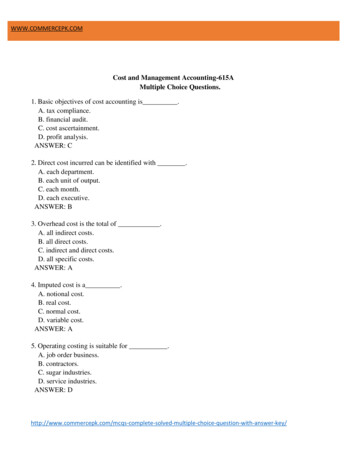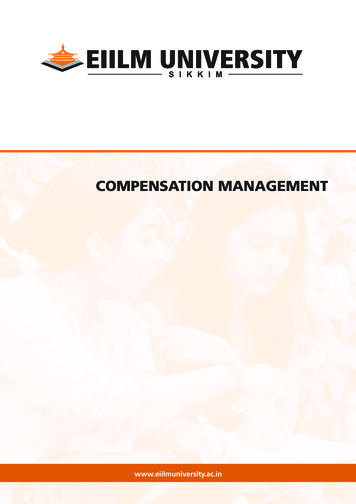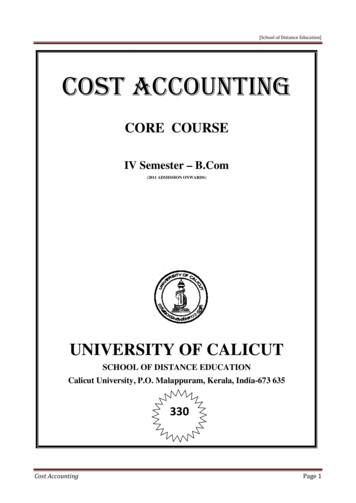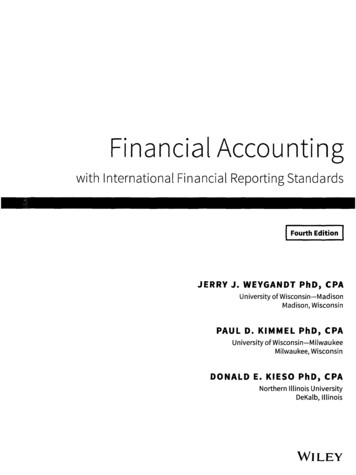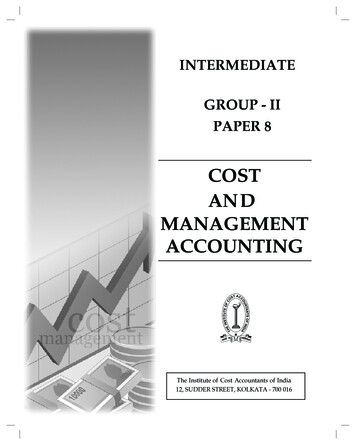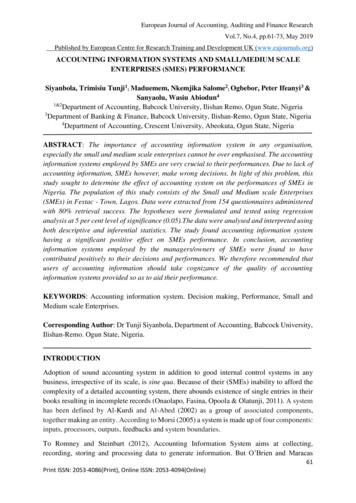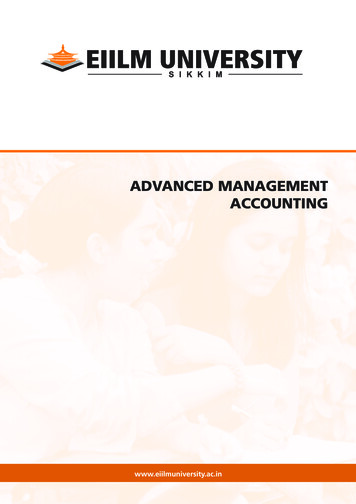
Transcription
ADVANCED MANAGEMENTACCOUNTINGwww.eiilmuniversity.ac.in
Subject: ADVANCED MANAGEMENT ACCOUNTINGCredits: 4SYLLABUSConcept of Management AccountingConcept; Tools of Management Accounting; Installation of Management Accounting System; Role of themanagement Accountant; Management Accounting as a career; Revision of Some Basic Cost Terms andConcepts: Cost Unit, Cost Centre, Profit Centre, Different Types of Costs and its Classification viz. Fixed,Variable, Semi-variable, Direct, Indirect, Marginal, Out of Pocket, Differential, Sunk Costs , Opportunity Cost ,Replacement Cost , Joint cost , Conversion Cost , Discretionary Costs , Committed Cost; Cost Tracing; CostAllocation; Cost Driver; Historical Costing; Absorption Costing; Marginal Costing; Standard Costing; UniformCosting.Analysis and Interpretation of Financial StatementsEssentials of Good Financial Statements; Tools of Financial Analysis: Comparative Financial Statements,Common size Statements, Trend Analysis, Statement of changes in Working Capital, Funds Flow, Cash Flow,Ratio Analysis; Basics of Working Capital Management: Working Capital Requirement Forecast , ImportantWorking Capital Ratios.Management Accounting and Managerial Decision MakingDecisions Making: Decisions Involving Alternative Choices, Pricing Decisions, Need for Revision of Budgets,Revision of Standards, Concept of Limiting Budget Factor; Divisional Performance Appraisal: Meaning ofDivisions, Reasons for Divisionalisation; Measurement of Divisional Performance: ROI Approach , ResidualIncome Approach; Concept of Transfer Price; Different Bases of Formulating Transfer Prices: Market Based,Cost Based , Shadow Price Based.Behavioral Aspects of Control, MIS, Reporting and Management AuditThe Concept of Group or Social Control Behavioral Theories Relating to Control; Some BehavioralImplications of Control through Budgets; Selection of a Proper Control Strategy; Concept of MIS; Developing aManagement Information and Reporting System; Levels of Management and their Information Requirements;Objectives of Management Audit; Distinction between Different Types of Audit; Conducting ManagementAudit .Contemporary Issues in Management AccountingTarget Costing; Responsibility Accounting; Inflation Accounting; Activity Based Costing; Quality Costing;Human Resource Accounting; Value Added Accounting; Life Cycle Costing: Product Life Cycle Costing ,Project Life Cycle Costing, Management, Accountant’s Role in Lifecycle Costing , Value Chain Analysis.Suggested Readings:1. Management and Cost Accounting, Drury C, Thomson Business Press.2. Accounting for Non-Accounting Students, Dyson J R,
MENTADVANCEDOVERVIEWThere are three strands to the course.FirstWe focus on the developments of formal Finance - basedmanagement accounting theory.SecondWe consider contemporary cost management issues includingactivity accounting, strategic cost analysis and managementaccounting in the digital economy.ThirdWe adopt a strategic and organisational perspective to planningand control systems design.These different approaches provide complementary appreciations of the management process in modern organisations.Some of the subject matter of the course will be dealt withacross the three strands, illustrating the conceptual richness ofmodern management accounting. The synthesis, reconciliationand explanation of different views is an important aspect of thecourse.At the conclusion of the semester, you are expected to:1. Have a fundamental understanding of mainstreammanagement accounting topics and their practicalapplications,2. Be able to effectively use quantitative tools to provide timelyinformation to decision-makers,3. Be able to grasp critical variables in decision-making scenariosand apply the appropriate analyses to make the rightdecisions,4 Be able to do well in group discussion settings and tocommunicate your ideas and thoughts effectively, and5. Do well in all aspects of this course & receive a good grade.ii
ENTCONCEPT OF MANAGEMENT ACCOUNTINGLesson No.TopicPage No.ACCOUNTINGLesson 1Introduction to Management Accounting1LessonLessonLessonLessonLessonDesigning & Installation of Management AccountingRole of Management AccountingFrom the WebMarginal CostingBudgetary Control & Standard Costing610131621Lesson 7Basic Cost Concepts26Lesson 8Practical Applications/ Case Study3023456ANALYSIS AND INTERPRETATION OF FINANCIAL STATEMENTSLesson 9Financial Statement Analysis33Lesson 10Lesson 11Techniques of Financial AnalysisStatement of Change in Financial Position3742Lesson 12Lesson 13Cash Flow StattementWorking Capital Management4852Lesson 14-15Financial Ratio’sMANAGEMENT ACCOUNTING AND MANAGERIAL DECISION MAKING59Lesson 16-17Decisions Involving Alternative Choices73Lesson 18-19Divisional Performance Appraisal85Lesson 20-21Transfer Pricing93Lesson 22Case Study102BEHAVIORAL ASPECTS OF CONTROL, MIS, REPORTING AND MANAGEMENT AUDITLesson 23Lesson 24-26Behavioural Aspect of ControlManagement Information System103109Lesson 27Introduction to Audit125Lesson 28Audit & Its Types129Lesson 29Management Audit134Leson 30Case Study139Lesson 31Practical Application of Concepts Under Study Unit 4140CONTEMPORARY ISSUES IN MANAGEMENT ACCOUNTINGvLesson 32Target Costing141Lesson 33Responsibility Accounting147Lesson 34-35Inflation Accounting152Lesson 36Activity Based Costing (ABC)162
ENTLesson No.TopicPage No.Quality Costing168Lesson 38Human Resources Accounting170Lesson 39Value Added Accounting181Lesson 40Life Cycle Costing187Lesson 41Value Chain Analysis192ACCOUNTINGLesson 37vi
ADVANCEDLESSON 1:INTRODUCTION TO MANAGEMENTACCOUNTINGAfter studying this chapter you should be able toExplain terms such as management accounting, cost accounting, andfinancial accounting Explain the main features of management accounting Differentiate between management accounting and financial accountingIntroductionManagers use management accounting information to choosestrategy to communicate it and to determine how best toimplement it. They use management accounting information tocoordinate their decisions about designing, producing andmarketing a product or serviceWhat is Management Accounting?Management accounting is very closely linked to cost accounting;so closely, in fact, that it is difficult to say where cost accountingends and where management accounting begins. Cost accounting simply aims to measure the performance of departments,goods and services. However, management accounting is much,much more and involves:1 The provision or information for management: Indeed,the role of the management accountant could well bedescribed as that of an ‘information manager’. Theinformation generated should be designed to assistmanagement, to control business operations and to helpmanagement with decision-making. In fulfilling this role themanagement accounting department/section must consultwith the users of the information, i.e. management, toassess its needs in terms of precisely what information isrequired and when, etc. The aim is, to provide managementwith a flow of relevant information, e.g. reports, statements,spreadsheets, etc. as and when required. A frequent flow ofinformation (weekly or monthly) should enablemanagement to respond to emerging problems/situationsas soon as possible. The early detection of problems meansearlier solutions & early action.2. Advising management: A key part of managementaccounting is to advise management about the economicconsequences and implications of its (proposed) decisionsand alternative course of action. In particular, this adviceshould answer a frequently overlooked question: Whathappens if things go wrong? (If interest rates go up? Or ifthe sales target is not achieved?)3. Forecasting, planning and control: A lot of managementaccount-ing is concerned with the future and predeterminedsystems such as budgetary control and standard costing. Suchsystems investi-gate the differences (i.e. variances) which ariseas a result of actual performance being different fromplanned performance in terms of budgets or standards. Inaddition, the management accountant should also beinvolved in strategic planning, e.g. the setting of objectivesand the formulation of policy. The forecasting process willinvolve accounting for uncertainty (risk) via statistical techniques, such as probability, etc.4. Communications: If the management accounting system isto be really effective it is essential that it goes hand in handwith a good, sound, reliable and efficient communicationsystem. Such a system should communicate clearly byproviding information in a form, which the user, i.e.managers and their subordinates, can easily understand(reports, statements, tabulations, graphs and charts).However, great care should be taken to ensure that managersdo not suffer from ‘information overload’, i.e. having toomuch information much of which they could well dowithout.5. Systems: The management accounting department/sectionwill also be actively involved with the design of cost controlsystems and financial reporting systems.6. Flexibility: Management accounting should be flexibleenough to respond quickly to changes in the environment inwhich the company/organization operates. Where necessaryinformation/ systems should be amended/modified. Thus,there is a need for the management accounting section/department to be involved with the monitoring of theenvironment on a continuing basis.7. An appreciation of other business functions: Those whoprovide management accounting information need tounderstand the role played by the other business functions.In addition to communi-cating effectively with otherbusiness functions, they also need to secure their cooperationand coordination, e.g. the budget preparation process relieson the existence of good communica-tions, cooperation andcoordination.External environmentFigure 1.18. Staff Education: The management accounting department/section needs to ensure that all the users of the informationit provides, e.g. managers and their subordinates, areeducated about the techniques used, their purpose and theirbenefits, etc.1ACCOUNTING MANAGEMENTLearning objectives
ADVANCEDMANAGEMENT9. Gate keeping: The management accounting department/section sits at a very important information junction (seeFigure 1.1). This gate keeping position places themanagement accounting section in a position of power; ithas access to (can send information to and from)management and subordinates, and communicates with andreceives a certain amount of information from the externalenvironment. Its power arises because it can control the flowof information upwards to management - or downwards tosubor-dinates. -ACCOUNTING10.Limitations: Although management accounting can, anddoes, provide a lot of useful information, it must bestressed that management accounting is not an exact science.A vast amount of the information generated depends uponsubjective judgment, e.g. the assessment of qualitativefactors or assumptions about the business environment.Management accounting is not the be all and end all ofdecision-making, it is just one of the tools which can helpmanagement to make more informed decisions.11.Being the servant: Finally, having established thatmanagement accounting is a tool, it must be emphasizedthat it is there to serve the needs of management.Managent Accounting, FinancialAccounting, and Cost AccountingAccounting systems take economic events and transitions thathave occurred and process the data in those transactions intoinformation that is helpful to managers and other users, such assales representatives and production supervisors. Processing anyeconomic transaction entails collecting, categorizing, summarizing, and analyzing. For example, costs are collected by costcategories (materials, labor, and shipping); summa-rized todetermine total costs by month, quarter, or year; and analyzedto evaluate how, costs have changed relative to revenues, say,from one period to the next. Accounting systems provideinformation such as financial statements (the income statement,bal-ance sheet, and statement of cash flows) and performancereports (such as the cost of operating a plant or providing aservice). Managers use accounting information (a) to administereach of the activity or functional areas for which they areresponsible and (b) to coordinate those activities or functionswithin the framework of the organization as a whole.Individual managers often require the information in anaccounting system to be presented or reported differently.Consider, for example, sales order information. A sales managermay be interested in the total dollar amount of sales todetermine the commissions to be paid. A distribution managermay be interested in the sales order quantities by geographicregion and customer-requested delivery dates to ensure timelydeliveries. A manufacturing manager may be interested in thequantities of various products and their” desired delivery datesto schedule production. An ideal database-sometimes called adata warehouse or inform -consists of small, detailed bits ofinformation that can be’ used for multiple purposes. Forexample, the sales order database will contain detailed, information about product, quantity ordered, selling price, and deliverydetails (place and date) for each sales order. The data warehouse2stores information in a way that allows managers to access theinformation that each needs.Management accounting and financial accounting have differentgoals. Management accounting measures and reports financialand non-financial information that helps man-agers makedecisions to fulfill the goals of an organization. Managers usemanagement accounting information to choose, communicate,and implement strategy. They also use management accountinginformation to coordinate product design, production, andmarketing decisions. Management accounting focuses oninternal reporting.Financial accounting focuses on reposing to external parties.It measures and records business transactions and providesfinancial statements that are based on gener-ally acceptedaccounting principles (GAAP). Managers are responsible for thefinancial statements issued to investors, government regulators,and other parties outside the orga-nization. Executive compensation is often directly affected by the numbers in thesefinan-cial statements. It is not difficult to see that managers areinterested in both management accounting and financialaccounting.Cost accounting provides information for managementaccounting and financial accounting. Cost accounting measuresand reports financial and no financial informa-tion relating tothe cost of acquiring or utilizing resources in an organization.Cost accounting includes those parts of both managementaccounting and financial accounting in which cost information iscollected or analyzed.The internal reporting-external reporting distinction justmentioned is only one of several significant differencesbetween-management accounting and financial accounting.Other distinctions include management accounting’s emphasison the future-that’s bud-geting-and management accounting’semphasis on influencing the behavior of man-agers andemployees. Another distinction is that management accountingis not nearly as restricted by GAAP as is financial accounting. Forexample, managers may charge interest on owners’ capital tohelp judge a division’s performance, even though such a chargeis not allowable under GAAP.Reports such as balance sheets, income statements, andstatements of cash flow are common to both managementaccounting and financial accounting. Most companies adhere to,or only mildly depart from, GAAP for their basic internalfinancial statements. Why? Because accrual accounting provides auniform way to measure an organization’s financial performancefor internal and external purposes. However, managementaccounting is more wide-ranging than financial accounting’semphasis on financial state-ments. Management accountingembraces more extensively such topics as the develop-ment andimplementation of strategies and policies, budgeting, specialstudies and forecasts, influence on employee behavior, and nonfinancial as well as financial information.
Cost management is not practiced in isolation. It’s an integralpart of general man-agement strategies and their implementation. Examples include programs that enhance customersatisfaction and quality, as well as programs that promote“blockbuster” new- product development.Distinction Between Management Accounting andFinancial AccountingThe 12 principal differences between management and financialac-counting are described here.1. Necessity- Financial accounting must be done. Enougheffort must be expended to collect data in acceptable formand with an acceptable degree of accuracy to meet therequirements of the Financial Accounting Standards Board(FASB) and other outside parties, whether or not themanagement regards this information as useful.Management accounting, by contrast, is entirely optional, nooutside agencies specify what must be done or indeed thatanything need be done. Because it is optional, there is nopoint in collect-ing a piece of ( management accountinginformation unless its value to management’s believed toexceed the cost of collecting it.2. Purpose- The purpose of financial accounting is to producefinan-cial statements for outside users. When the statementshave been pro-duced, this purpose has been accomplished.Management accounting in-formation, on the other hand, isonly a- means to an end, the end being the planning,implementing, and controlling functions of management.3. Users- The users of financial accounting information (otherthan management itself) are essentially a “faceless” group.The managements of most companies’ do not personallyknow many of the shareholders, creditors, or others whouse the information in the financial statements. Moreover,the information needs of most of these external users mustbe presumed; most external users do not individuallyrequest the informa-tion they would like to receive. Bycontrast, the users of management accounting informationare known managers plus the people who help thesemanagers-ana1yze the information. Internal users4. Underlying Structure- Financial accounting is built aroundone fundamental equation: Assets Liabilities Owners’Equity. In manage-ment accounting, there are three types ofaccounting, each with its own set of principles.5. Source of Principles- Financial accounting informationmust be reported in accordance with generally acceptedaccounting principles (GAAP). Outside users need assurancethat the financial statements are prepared in accordance with amutually understood set of ground rules; otherwise, theycannot understand what the numbers mean. GAAP pro-videthese common ground rules.An organization’s management, by contrast, can employwhatever accounting rules it finds most useful for its ownpurposes. Thus, in manage-ment accounting, there may beinformation on unfilled sales orders, even though these arenot financial accounting transactions; fixed assets may bestated at current values rather than historical cost; certainproduction overhead costs may be omitted from inventories;or revenues may be recorded before they are realized-eventhough each of these concepts is inconsistent with GAAP.Rather than asking whether it conforms to GAAP, the basicquestion in management accounting is the pragmatic one: Isthe information useful?6. Time Orientation- Financial accounting records and reportsthe financial history of an organization. Entries are made inthe accounts only after transactions have occurred. Althoughfinancial accounting informa-tion is used as a basis, formaking future plans, the information itself is historical.Management accounting includes, in its formal structure,numbers that represent estimates and plans for the future aswell as informa-tion about the past. The objective offinancial accounting is to “tell it like it was,” not like it will be.7. Information Content- The financial statements that are theend product of financial accounting include primarilymonetary information. Management accounting reports dealwith no monetary as well as mone-tary information. Thesereports show quantities of material as well as its monetarycost, number of employees and hours worked as well aslabour costs, units of products sold as well as rupeeamounts of revenue, and so on.8. Information Precision- Management needs informationrapidly and is often willing to sacrifice some precision inorder to gain speed in reporting. Thus, in managementaccounting approximations are often as useful as, or evenmore useful than, numbers that are more precise. Al-thoughfinancial accounting cannot be absolutely precise either, theapproximations used in management accounting are broaderthan those in financial accounting.9. Report Frequency- Corporations issue detailed, financialstate-ments only annually and less detailed interim reportsquarterly by con-trast, fairly detailed management accountingreports are issued monthly in most larger organizations; and3ACCOUNTINGCost management has a broad focus. For example, it includesbut is not confined to-the continuous reduction of costs. Theplanning and control of costs is usually inex-tricably linked withrevenue and profit planning. For instance, to enhance revenuesand profits, managers often deliberately incur additional costsfor advertising and product modifications.information needs are relatively well known because thecontroller’s office solicits these needs in designing or revisingthe management accounting system.MANAGEMENTThe term cost management is widely used in businesses today.Unfortunately, there is no uniform definition. We use costmanagement to describe the approaches and activities ofmanagers in short-run and long run planning and controldecisions that increase value for customers and lower costs ofproducts and services. For example, managers make deci-sionsregarding the amount and kind of material being used, changesof plant processes, and changes in product designs. Information from accounting systems helps managers make suchdecisions, but the information and the accounting systemsthemselves are not cost management.ADVANCEDCost Management and Accounting Systems
ADVANCEDreports on certain activities may be prepared weekly, daily, orin a few instances in real time.MANAGEMENTACCOUNTING10.Report Timeliness- Because of the needs for precision anda review by outside auditors, plus the time requirements oftypesetting, finan-cial accounting reports are distributedseveral weeks after the close of the ending December 31generally are not received by shareholders until March orApril. By contrast, because management accounting reportsmay contain information on which management needs totake prompt action, these reports are usually issued within afew days of the end of a month.11. Report Entity- Financial statements describe theorganization as a whole. Although companies that dobusiness in several industries are required to report revenuesand income for each industry, these are large segments of thewhole enterprise. Management accounting, by contrastfocuses, mainly on relatively small parts of the entity that is,on individ-ual products, individual activities, or individualdivisions, departments and other responsibility centers. Aswe shall see, the necessity for divid-ing the total costs of anorganization among these individual parts creates importantproblems in management accounting that do not exist infinan-cial accounting.12.Liability Potential- Although it happens infrequently, acompany may be sued by its shareholders or creditors forallegedly reporting mis-leading financial information in itsannual report. By contrast, as previously stated, managementaccounting reports need not be in accord with GAAP and arenot public documents. Although a man-ager may be heldliable for some inappropriate action and managementaccounting information conceivably may have played somerole in has or her taking that action, it is the action itself, notthe management account-ing documents, that gives rise tothe liability.Surveys of Company Practice“A Day in the Life” of a Management AccountantWhat do management accountants do? The following table,based on a survey of CMAs, shows the percentage of respondents who namd a particular work activity as in the top fivework activity interms of time devoted to the activity.In terms of importance, management accountants ranked theabilities and skills needed to succed as follows:1. Communication skills2. Ability to work on a team3. Analytical/problem solving skill4. Solid understanding of accounting5. Understanding of how a business functions6. Computer skillsWhat changes in work activities are projected in the future formanagement accountants?Projected to become more important are. Internal consulting Process improvement Long-term strategic planning Performing financial and accounting analysis Computer system and operationProjected to become less important are Accounting systems and financial reporting Consolidation Managing the accounting/finance function Accounting policy Short term budgeting Project accountingThe increasing use of information technology in the future wasseen from the survey as helping management accountantsspend a lower percentage of their time on data collection andfinancial statement preparation and a higher percentage onfinancial analysis.The survey indicates a clear shift away from activities wetraditionally think of as the core of the controller’s responsibilities- managing the function, ensuring business controls, andplanning and reporting- toward activities we think of asbusiness partnering- strategic planning, business leadership,analyzing and interpreting information, decision making,process improvements, and performance evaluation.Accounting system and financial reporting62%The following question-answer format summarizes thechapters learning objectives.Managing the accounting function42%1. What information does cost accounting provide?Internal consulting42%Short-term budgeting37%Long-term strategic planning25%Financial and economic analysis24%Computer system and operations21%Process improvement20%Performance evaluation17%Tax compliance14%Accounting policy13%Project accounting11%Consolidations11%4Cost accounting measures and reports financial informationand other information related to the acquisition orconsumption of an organization’s resources. Costaccounting provides information to both managementaccounting and financial accounting.2. How do management accountants support strategicdecisions?Management accountants contribute to strategic decisions byproviding information about the source of competitiveadvantage and by helping managers identify and build acompany’s resources and capabilities3. What role do management accountants perform?
ADVANCEDIn most organizations, management accountants performmultiple roles: problem solving (comparative analyses fordecision making), scorekeeping (accumulating data andreporting reliable results), and attention directing (helpingmanagers properly focus their attention).MANAGEMENTNotesACCOUNTING5
ADVANCEDLESSON 2:DESIGNING & INSTALLATION OF MANAGEMENT ACCOUNTINGMANAGEMENTACCOUNTING2. Value-chain and supply-chain analysis- Value chain refersto the sequence of business functions in which usefulness isadded to the products or services of a company. The termvalue refers to the increase in the usefulness of the productor service and, as result its value to the customer. Exhibit 2.2shows six business functions-research and development(R&D), design, production, marketing, distribution, andcustomer service Management accountants provideinformation managers need to make decisions in each ofthese six business functions. We illustrate these businessfunctions using the example of SONY Corporation’stelevision division.Learning ObjectivesAfter studying this chapter you should be able to: Identify the areas, which influence the design of managementaccounting system Design the Management accounting system. Understand the procedure of installing the management accountingEnhancing the Value ofManagementaccounting SystemsThe design of a management accounting system should beguided by the challenges facing managers. Exhibit 2.1 presentsfour themes common to many companies. The customer focustheme is particularly critical. The other three themes-value-chainand supply-chain analysis, key success factors, and continuousimprovement and benchmarking-are geared to improvingcustomer focus and customer satisfaction. Managementaccounting helps manager’s focus on these four themes. Research and development -Generating and experimenting1. Customer focus- The number of organizations aiming to be“customer- driven” is large and increasing. For example, AseaBrown Boveri (ABB)-a global manufacturer of industrialproducts-gives high priority to customer focus:Customer Focus is a guiding principle the way we dobusiness. It is an attitude about everything we do thatprompts us to constantly ask ourselves: “How can I addvalue for the customer?” Our commitment to CustomerFocus has been reinforced by the measurable impacts it hashad on employee morale and the bottom lineThe challenge facing managers is to continue investingsufficient resources in customer satisfaction such thatcustomers who provide a company the most profits areattracted and retained. It is for this reason that airlinecompanies pay special attention to their most frequenttravelers. The management accounting system must alsotrack whether the internal business functions are addingvalue to customers.CustomerFocusValue chainand supplychain analysisKey Success FactorCost and efficiencyQualityTime innovationKey themes in Management decision makingExhibit 2.16with ideas relat
Human Resource Accounting; Value Added Accounting; Life Cycle Costing: Product Life Cycle Costing , Project Life Cycle Costing, Management, Accountant’s Role in Lifecycle Costing , Value Chain Analysis. Suggested Readings: 1. Management and Cost Accounting, Drury C, Thomson Business Press. 2. Accounting



